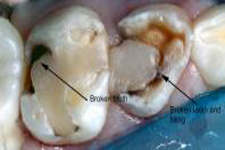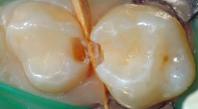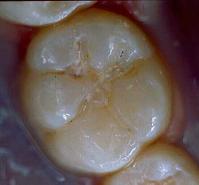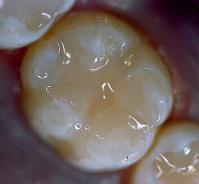Dental Trauma
These images show before and after photos of a 10 year old boy who was struck in the mouth by another child’s lunch box. The broken tooth, on the right, was repaired using an acid etch technique and a variety of resin materials. Because of white markings on his other undamaged front teeth, resin materials were artistically and esthetically applied to his broken tooth to match their appearance, as shown on the left.
Restorative Dentistry – Tooth Fillings
For small cavities in permanent or primary teeth, we place a variety of tooth coloured, resin (plastic) filling materials. The resin materials we use today are bonded to the tooth which increases adhesion of the filling material to the tooth as well as strengthening the decayed tooth. We stock a variety of resin filling materials so that we can match the right material properties and colour to each tooth. Our goal is to not only provide an excellent esthetic result but also a strong functional filling. Shown are immediate before and after photos of two resin fillings placed in primary molars.
Restorative Dentistry – Front Teeth
In many cases, we provide care for children who are affected by early childhood tooth decay, a very aggressive form of decay that will rapidly consume a child’s teeth unless treated quickly and aggressively. The photo of decayed front teeth shown on the left was taken just before treatment was provided to this three year old. The second photo on the right was taken six months later at the child’s next check-up appointment. The decay in this child’s front teeth had almost destroyed them. Filling them was not an option because of the extensive destruction. Repair of these teeth, with resin (plastic) bonded crowns, was important so that this child could eat and speak normally. These pictures illustrate what a beautiful functional and esthetic result we can achieve with modern dental treatment.
When there is more destruction of the front teeth, as shown in the photo on the left below, metal crowns with plastic tooth coloured facings are recommended. The pictures below show such a case. The postoperative photo, on the right below, was taken 2 years after treatment and indicates how esthetic and durable these crowns are in the young child.
Restorative Dentistry – Large Cavities in Back Teeth
We provide care for children who often have very large cavities in one or more of their primary molars . Treating these cavities with large plastic fillings, although cheaper initially, will ultimately lead to failure and a need to retreat. In the long run, this is more expensive for you. The alternative is to place stainless steel crowns on teeth which have cavities too large for fillings. Although they are not esthetic, as they are made with surgical grade stainless steel, they are very functional and durable, lasting until the primary molar is replaced by the permanent tooth. The photos show the same child before and after placement of a stainless steel crown and a resin tooth coloured filling.
Restorative Dentistry – Poor Choices to be Avoided
Our goal is to provide your child with treatment which is both scientifically proven and which will, based on our years of experience, give your child exceptional service. But, many parents ask why we cannot simply place fillings in their child’s baby (primary) molars. After all, these teeth will fall out. The pictures shown below are examples of what happens when inappropriate treatment is chosen either by parents or dentists. Unfortunately, the teeth shown in these pictures cannot now be saved and must be removed.

Dental Sealants – Preventing Decay in Primary and Permanent Teeth
Dental sealants are a form of preventive treatment. This involves bonding a resin (plastic) coating onto the chewing surface of a tooth. Teeth which are good candidates for sealants are those which have deep grooves in which food and bacteria collect. Leaving this accumulation in the grooves will lead to tooth decay. Our dental assistants are fully certified to place sealants. We know from scientific research and our own experience that the main reason sealants fail is because the tooth was not kept absolutely dry during placement. Our process involves isolating the tooth to be sealed with a rubber dam after the child has received a small amount of freezing around the tooth. This is the BEST way to ensure a successful outcome. The tooth is then thoroughly cleaned, roughened with an acid solution and the sealant bonded into place. Sealants, when intact, are 100% effective at preventing tooth decay.












